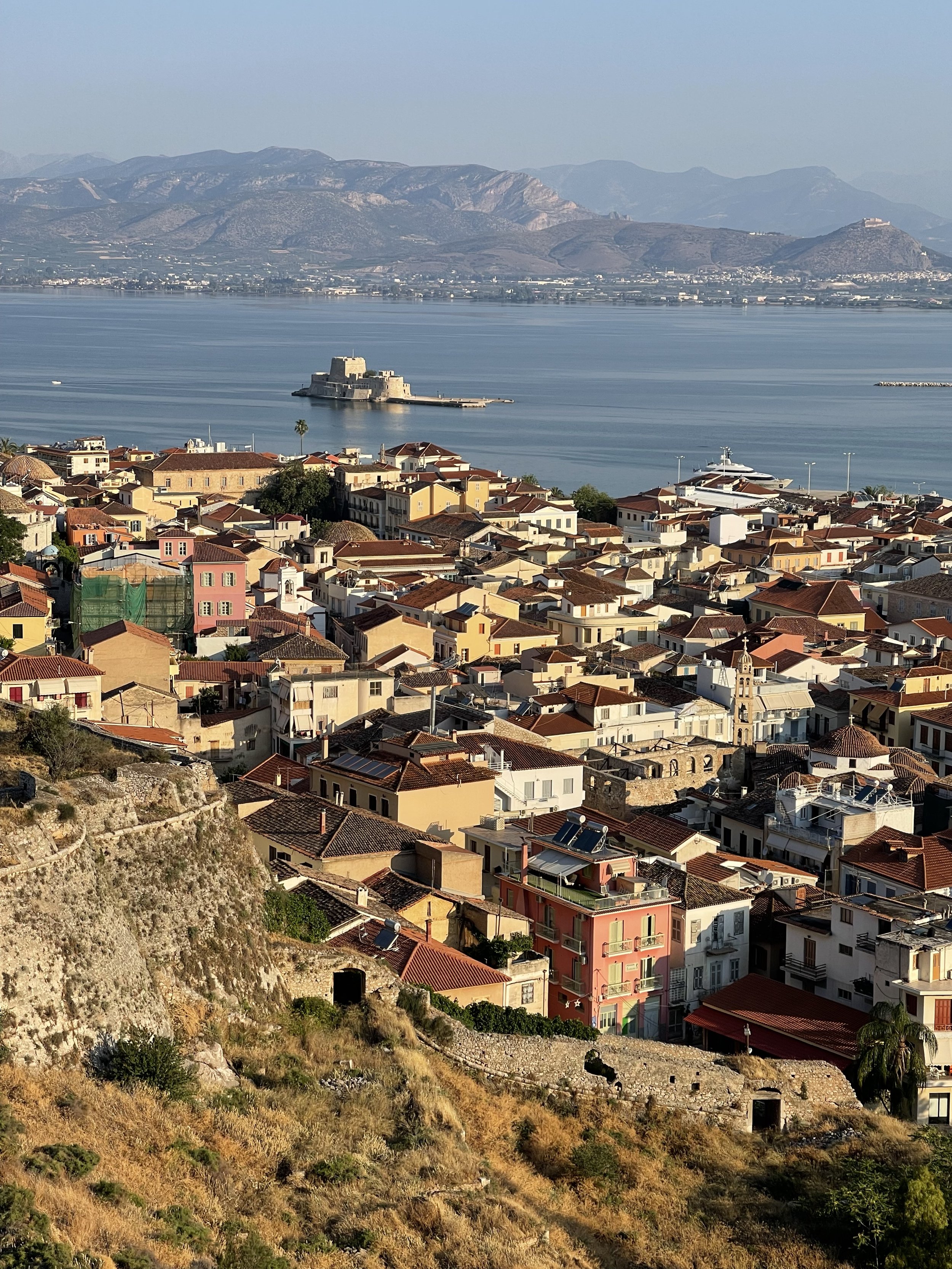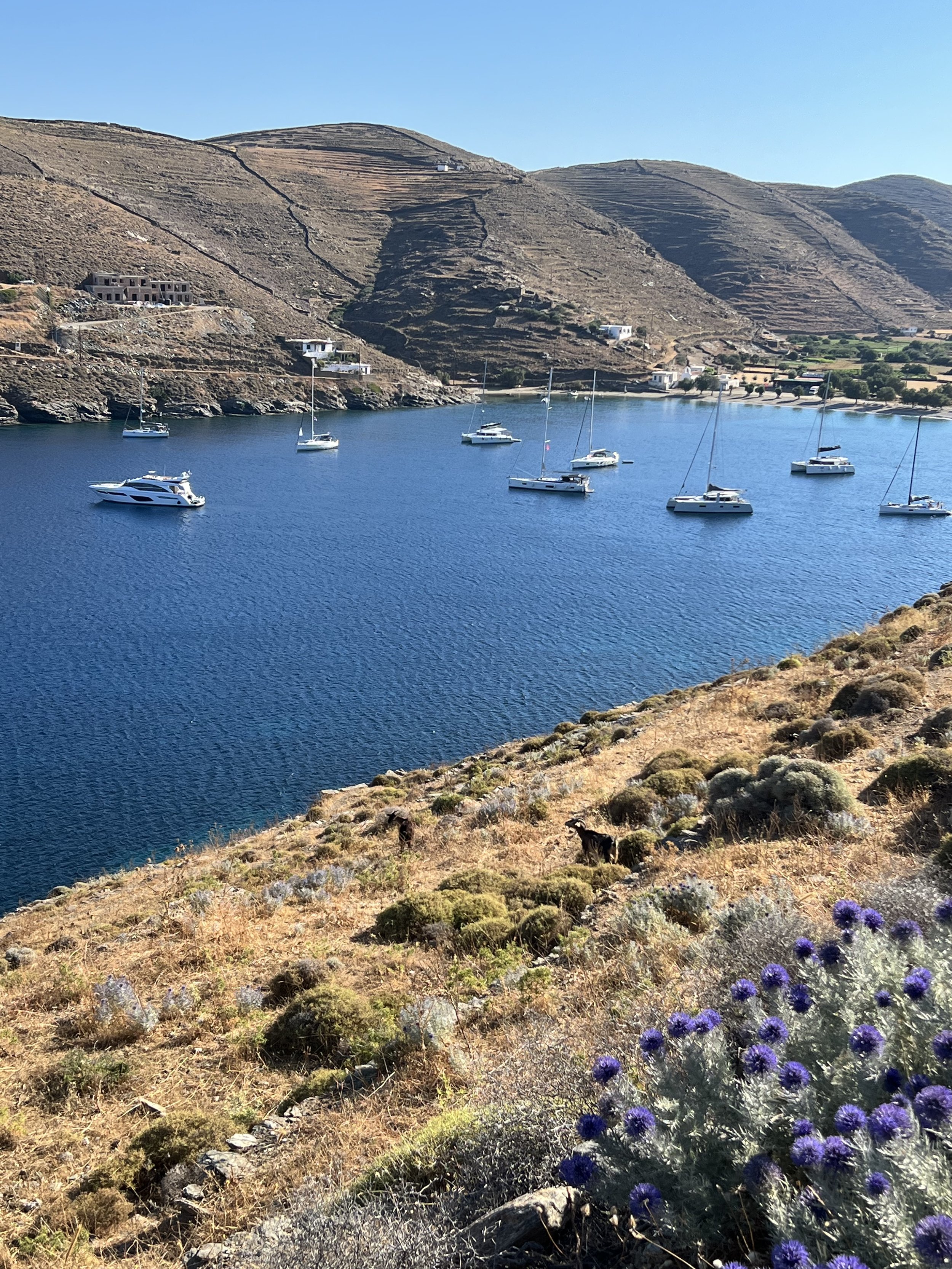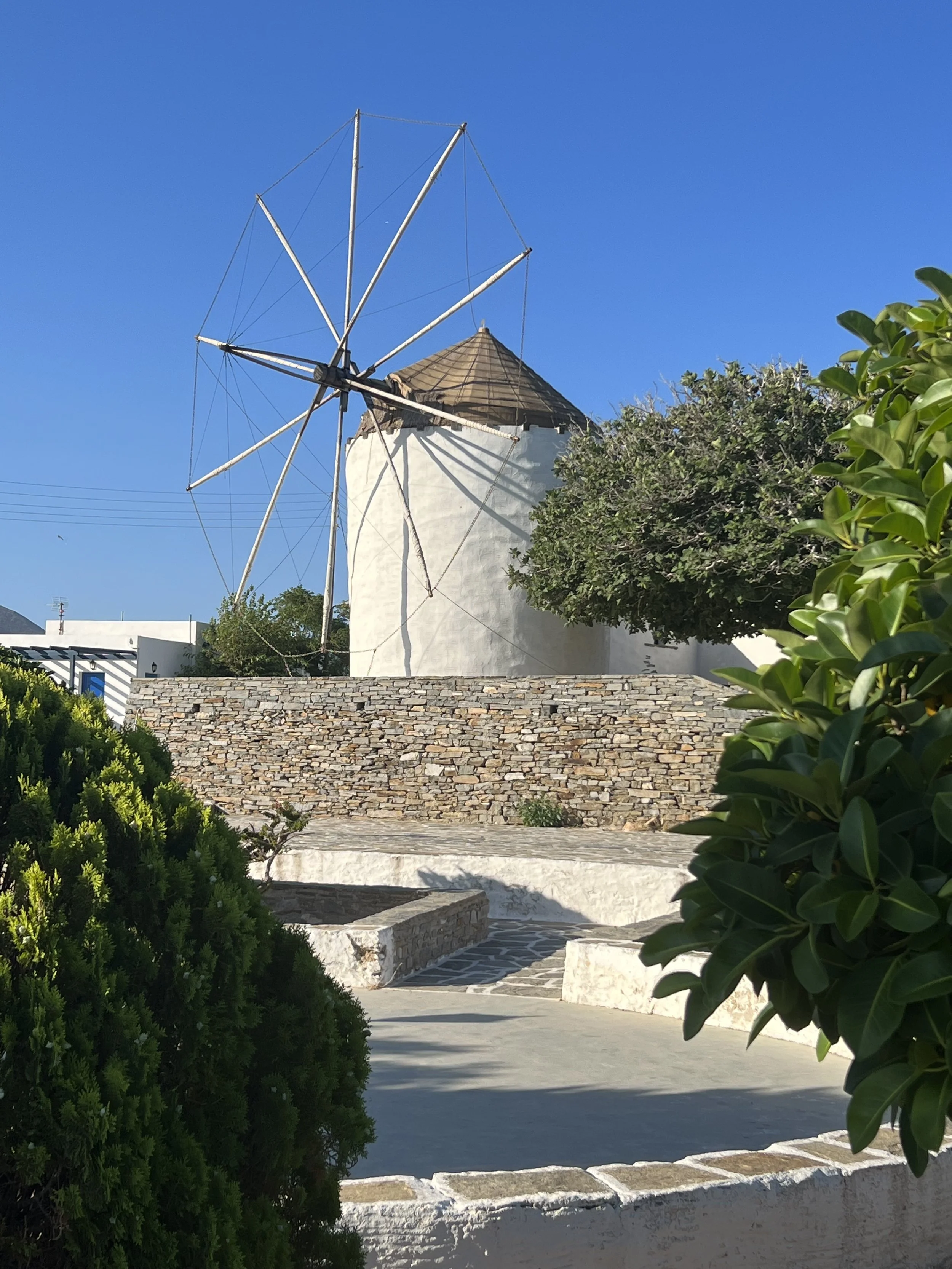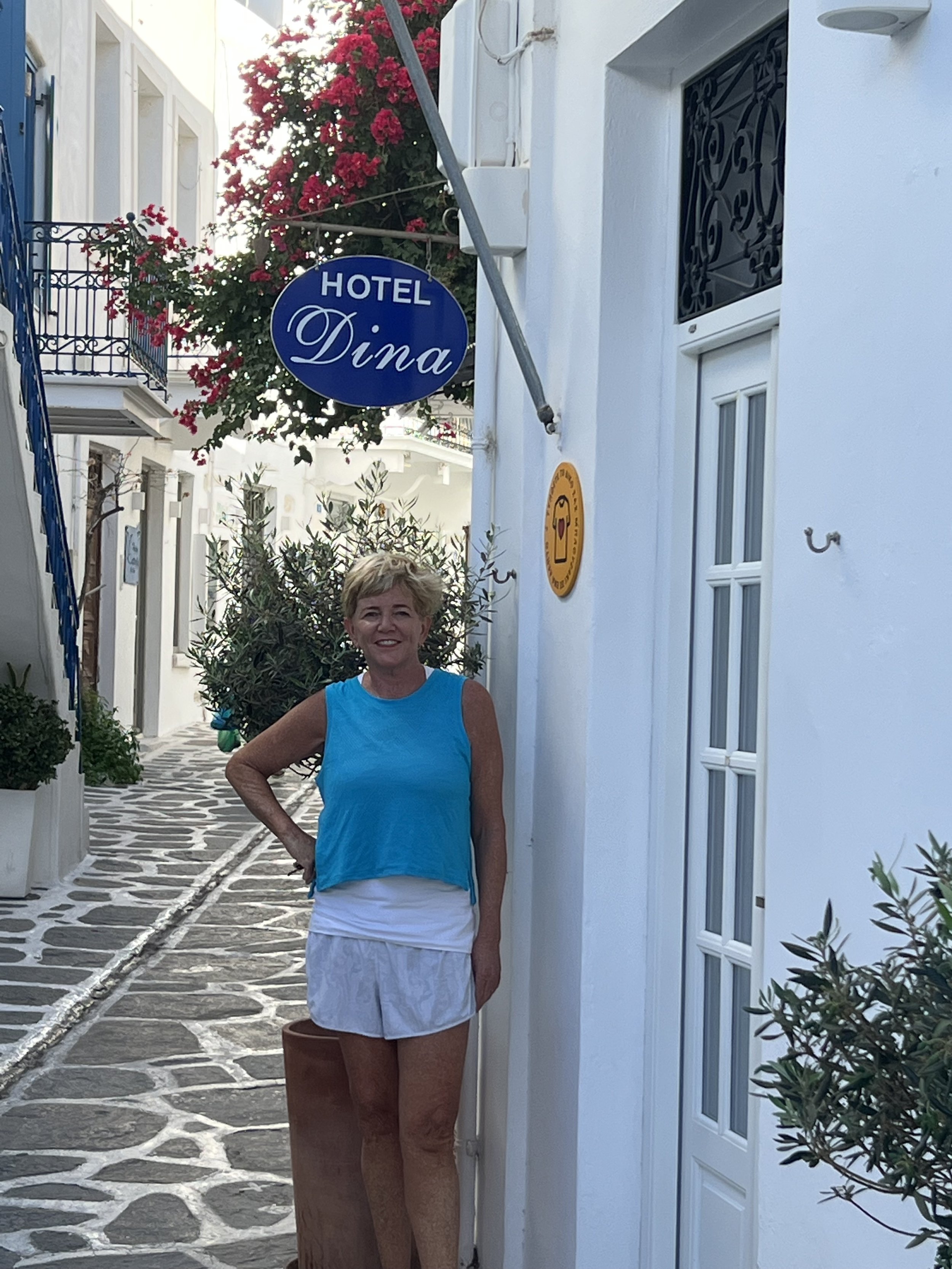Argolic Gulf to the Cyclades
Once we’d farewelled our guests, we headed back to Porto Heli which was by now starting to feel like a home away from home. We wanted to get laundry done and do our provisioning where the markets were known to us before heading northwest to Navplion. Our plan at this point in the trip also included doing some research into a place to haul out for the winter. Gavin has been very firm on finding a place that is close to Athens where we can get quality work done on the boat, including but not limited to, new solar panels mounted to the davits - it’s clear we need more electricity generating solutions to keep this boat powered. As it often happens, you put out the wish for a solution to your query and miraculously the answer arrives. This came to us via two serendipitous encounters with fellow cruisers who held high praise for Basimokopolous, a place we’d never heard of. The first glowing recommendation came from a Kiwi couple we met on Ermione, Murray and Lyn McPhail, from Gisborne and sailing on Birgitta. Then, again on Ermione, a Frenchman called Andre sailing his Outremer Catamaran, Aspara, who also hauls out there gave very positive testimony to their yard and workmanship. Basimokopolous is a yard versus a marina and is located in Koiladas, Argolic Gulf, a two hour drive from Athens and about a 2-hour sail from where we were. We had to go visit in person to satisfy our curiosity (and make a decision) so it was just as well it was close to Navplion; we could stop there on the way.
The anchorage is in Kiladha Bay opposite the village of Kiladha in southeastern Argolis, Greece. The first thing you notice as you enter the bay is a massive gash in the cliffside, which is actually a huge cave of some significance. In fact, Fragthi Cave is one of the most famous and important caves in all of Europe. It dates back to 20,000 BC and shows continuous human occupation for over that time. During evacuations in the 1960’s they found what is said to be one of the oldest full skeletons of a male, from the Mesolithic period, that’s 8,500 BC! It boggles the mind how old this place is. We took our dinghy over early one morning and flew our drone inside, upsetting the many birds who call the cave home, but it provided us with some good video. They light the cave at night which is spectacular to view from either your boat or the town.
We visited the boat yard and were sufficiently happy to make a booking. It’s not flash by any means but the people are nice and its reputation is excellent. Basimokopolous is also a word with six syllables, I like that. We’ll be hauling out at the end of September.
Now it was on to Navplion, (also spelled Navplio) a beautiful coastal city in the Argolis located on the eastern Peloponnese. We’d heard great things about this place from fellow cruisers and in every guide book. The city is rich in ancient history that expands over centuries with Venetian, Byzantine, Frankish, Turkish and Greek occupation.
We entered the harbour of Navplion on a perfectly calm evening and the first site we saw was the small island Castle of Bourtzi built on a rock close to, but inside, the entrance. The Venetians completed its fortification in 1473 to protect the city from pirates and other invaders from the sea. Apparently it had flame throwers in it! We thought it was a perfect spot to put our anchor down in front of and wondered why no one else had. We checked the charts carefully to see if there was any notice that anchoring was forbidden, but there wasn’t any, yet all the other boats here were stern to tied to the town quay. Oh well we thought, we’ll buck the trend.
I began whipping up a Pasta Aglio for dinner, by now is was 8pm. Gav was in the shower when I heard sirens roaring from the shore. I peaked out and there were two police cars with their lights flashing and sirens on and a group of policemen waving frantically towards us. Pretty much every other person in the town was staring out at us as well, we definitely stopped traffic. Gav came up and confirmed my suspicion, we’d broken some code by anchoring out. We pulled up our anchor and made our way towards them. Six policemen were all standing in a sort of Haka crouch, hands on their thighs, knees bent, all in their uniforms and one man was yelling ‘you can’t anchor here’ with a tone that implied we were stupid for even considering such a thing. We apologised and said we hadn’t seen a no-anchor note in the Greek Water Pilot book or on the charts and he replied that we should ‘just know that’. It would be difficult for us to ‘just know that’ when we’ve been anchoring in harbours all over Greece without issue, but of course we’ll know that now about Navplion. We made our way to the town quay and Gav was readying the fenders and ropes. I noticed that although the cops insisted we move to the town quay, and drove alongside watching to ensure we did, they provide no assistance to help you tie up. You’re at the mercy of the people passing by to take a rope. Lucky for us we were celebrities by now having caused such a stir in the town. A young German couple who liked the look of our boat helped us in.
We stayed here for two nights and it turned out to be well worthwhile. Our first adventure the next morning was to walk up the Castle of Palamadi, an ancient Venetian fortress built during their second occupation of the area, (1686-1715). It was later captured by the Ottomans and remained under their control until 1822 when it was captured by the Greeks. There are 1000 steps carved into the rock and walking up this is like an intense stair master workout. It seems to go on forever and then finally you arrive on top and are gifted with the most spectacular views and aspect - you totally get why the Venetians thought to build a fortified castle here, but you do marvel on just how they did it.
Later that day we hired Kostas, a delightful and chatty taxi driver to take us to the ruins of Mycenae, specifically, the Citadel of Mycenae on the Plain of Argos and also some other nearby ruins. The Citadel of Mycenae is considered one of the most important archaelogical sites in Greece, built somewhere between 1350- 1200 BC and best known in Greek Mythology as the city of Agamemnon, the King of Mycenae who led the expedition against Troy during the Trojan War. Having just read a few historical fiction novels of that ilk, I was in my element being here and imagining those characters who’d lived here before, not just the mythological ones but the Mycenaeans, who by all accounts were an advanced group of humans who just suddenly phased out of existence by 1100 BC. However, it was very hot this day and for the first time in two years, we felt the force of big tourism’s return, there were loads of people and tours and you had to be quick on your feet to get past them. The Museum of Mycenae at the Citadel site was excellent with beautiful artefacts from that period.
We left Navplion and started making our way east, preparing to cross to the Cyclades. After two nights in bays first on Dhokos and then Soupa on the mainland, (staring across to Hydra) we decided to make our dash across to Kythnos in the Cyclades, a journey of around 40 nautical miles. This will forever be known as the sail that broke me. The forecast said northerly winds, 20 knots, gusting 25 and I was okay with that, or thought I was. We got out there and it turned out to be nor’easterly winds of 30+ knots, gusting 35+ and the side chop and big swell were very unpleasant; picture waves crashing over the helm stations, noisy, chaotic situation all round. Initially we had 2 reefs in, then 3, and still the boat was cutting/banging through the sea going mostly 10 knots. The next four hours would be fairly terrifying for me, Gav would later recall it as one of the best sails of his life. He wanted to test the boat in big wind which we hadn’t done before and she performed marvellously, not so much his wife. In fact I was pretty useless to help at all but was pleased I had the presence of mind to pull out the life jackets before it got too hairy. I have no other words for this except that from this experience, I’ve decided for long passages, in the Cyclades in particular, we will always have another experienced sailor bloke on board.
We arrived at Kythnos and immediately felt the cool vibe of this new part of Greece we’d entered. It’s super windy in the Cyclades, the Meltemi winds aren’t easy, and anchoring in 20/25 knots isn’t fun, especially with so many boats around. But you’ve no choice but to get used to it. The landscape is also confronting, very much what I imagine Mars would be like, barren and dramatic.
While we didn’t visit every island we’d hoped to in the Cyclades, we did have fun sailing between Siros, N. Siros, Rinia, Mykonos, Paros and Antiparos - and enjoyed some great anchors and amusing sites - pretty much always in big wind. Our arrival here seemed to coincide when teenagers were just out of high school for the year and we saw heaps of boats carrying large groups of gorgeous young people whooping it up.
On Paros we anchored at Naousa Bay for a couple of days, home to a delightful and well kept traditional Greek village of the same name. We anchored on the western side about a kilometre from Naousa town and the two times we took our dingy to shore we got soaked solidly from the big swell. Still it was worth it to look around this pristine Greek town, the locals here take great pride in their city and keep it tidy and authentic, and there are some really edgy shops sprinkled about. I was aching to do some ‘retail therapy’ but with Gav in tow, that would have to wait!
Our good friends Davo and Vera from California joined us on the 2nd of July. We opted to collect them in Parikia on Paros which is where the ferry comes in. We really bonded with this town for a few reasons, the old town is charming beyond compare, the markets are bountiful and there’s even a gourmet food store. There are also great restaurants and good anchor holding in the Meltemi. We even found a place to get haircuts although I was shocked when my hairdresser used electric shears to cut my entire head of hair. Still, it was only 30 euro for both Gavin and I and eventually, it will grow out. I did say short, she went full military.
Prior to Davo and Vera’s arrival we’d been looking at the wind forecast and it wasn’t great. The Meltemi was due to blow in the late 20’s gusting 30’s for the whole time they would be on board with us. As it turned out there were some freaky moments and we take our hats off to them for being such great sports, including the event what we’ll now always refer to as The Trauma Bay Incident. It’s real name is Alike Bay and it’s on Paros. We anchored up in some fairly calm winds, had to move once as we were too close to another boat, and just as well we did because when later it came in blowing big, at least we were well away from them. But it didn’t stop us from dragging later in a 40-knot gust and then suddenly it was all on, us trying to pick up anchor in 30+ knots and having real difficulty controlling the bow. Davo and Gav were up with the anchor, working the bridle (which had malfunctioned) and I was trying, and failing, to keep the bow to wind. At one point it looked like we could hit the rocks. It was as bad as it gets. But lo and behold we got out of there and ended up anchored in a bay further south. Davo and Vera took this all with great spirit and humour and even seemed somehow to enjoy it. I was pale as a ghost and a tad freaked out, preferring to host dear friends in less life or death situations.
We cooked burgers on board for 4th of July on Antiparos and later had a dance party - playing only American music. We danced raucously, sang a few songs, watched the sunset and reflected on our many years of friendship and travel. I’m so grateful we had this time together with them and look forward to doing it again, hopefully with less wind!
The Sailing Six, our group of friends from NZ with a long history together of sailing (and other) adventures, were arriving on the 7th of July. Luckily we were in Parikia where we’d dropped off Davo and Vera, as they were arriving there on ferries from other Greek Islands they’d been visiting.
Knowing we might not get another chance this trip, the girls immediately headed into Parikia’s old town for a spell of retail therapy. We’re very good at this individually but excel as a team and we had a wonderful time. Then we did some provisioning for the boat and made our first meal on board. The next morning we did a big walk around the town before setting sail to Antiparos.
The forecast for this group’s visit with us was meant to be calm, virtually no wind, but that dream lasted just a day or two. This I now know is to be expected when sailing in the Cyclades, there is relentless wind no matter what the forecast says. We did have a calm anchor on Antiparos which was interesting to experience as just days before we’d been there with Davo and Vera and it was uncomfortably windy.
The ancient ruin, an archaeological site at Despotiko island sits just across from where we were anchored on Antiparos. Once again it was closed the day we were there, (it had been closed as well when Davo and Vera were with us) but a man in a fancy tender came along and told us where a break in the fence was situated and suggested we just go have a look. We took his advice and it was well worth it.
A plan was forming to enlist the Sailing Six to get us as far east as possible and close to Turkey. We needed to get there quickly in order to get out of the EU and ultimately obey the 90-day Schengen visa rules, bearing in mind we will need some time back in Greece to haul out. On our own this 67 nautical mile passage in big wind would definitely fit into the category of something I will never do again without an experienced bloke or two on board, so it’s just as well these guys were keen to help.
When we left Antiparos it was quite calm to start with and then the wind kicked in just near Naxos. It was fierce and challenging but I felt safer with the others on board, even if most of us were feeling ghastly. It was getting windier and windier so Gav stopped in a wee bay called Panokoufonisi and five of us, (apart from him) left the boat to have a walk and get some lunch. The windy conditions meant the skipper was best placed on board and when we got back to the boat a couple of hours later, he’d formed his plan. He advised us that we were to sail east to Nixos Levitha (Levitha Island) which effectively meant another 5 hours sailing. In hindsight his decision was right, bringing us closer to Leros and escaping a long sail the next day, but at the time, many in our group felt deflated at the idea of sailing on in the current extremely windy conditions. Jamie and Gavin however were like two boys on sailing camp, they couldn’t keep the smiles of their faces. So the remaining four of us adopted our own strategy to cope with the next five hours, some of us were sick, some listened to music or pod casts, some slept with the aid of seasickness meds, some read. I won’t say who did what! We arrived there in the evening and tied up to a mooring and the girls immediately whipped up a nice dinner, preceded by gin and tonics of course, we needed them!
The next day it was a short two-hour sail to Leros. On Leros we met up with good friends of Piera’s, Kiwi’s Cate and her partner Dave on NOETA. These two are legends in the Med cruising scene, I follow their blog and both Gavin and I were delighted to finally meet them. We ended up hosting a wee drinks party with other Kiwis we found anchored in Lakki on Leros before having a nice dinner with Cate and Dave and the Sailing Six on Waiata.
From Leros we had an excellent sail (enjoyed by all) to a wee bay on N. Kalimnos called Pallionisos where we tied up to a mooring and in doing so, you agree to have dinner at the local taverna, (who own the mooring) which was most excellent. The next day we went for a walk up the hill out the back and spotted lots of goats and beehives amongst the barren landscape. The following day saw us sail to Nisos Pserimos, where we anchored in Vathy Bay. By now there was a growing sense of urgency knowing our time out at sea was running out as we’d booked into the Port Marina on Kos for two nights from the next day. While it was very windy at anchor at Vathy Bay, we spotted a calm, white sand beach tucked in a corner onshore. Gav took the three girls in the dinghy and once there we all did a Dead Sea Mud Body Treatment. We must’ve looked a site to the other boaties parading about in full mud. The girls all swam back to the boat for exercise.
Tying up in the old port at Kos was a hoot, lots of yelling and gesticulating from the marina staff. They fit you in tight, like sardines, they’re kind of rude as well, but it’s just their way. We had some excellent meals out on Kos, more shopping, visiting ruins and some even watched the Irish beat the All Blacks in a sports bar nearby, not a highlight! In fact we really just relished the final two days with our good mates as they both were heading off to other destinations on Saturday as we sailed on to Turkey.
Gavin and I checked out of Greece and sailed to Turkey on the 16th of July, a short trip (90 minutes) but what a beautiful sail we had. We had help from our agent to clear in at Bodrum tying up to the Customs Dock in the very busy marina. As I write this we are cruising the Carian Coast in Turkey, in tandem once again with our mates Anna and Hamish on Aratui, and it’s hot, 39 degrees most days and the water temperature is 28! There’s also less wind here (so far) which is a nice change.
In other news both Gavin and I caught Covid here and that has been a real leveller! More on that in the next edition.
Thanks for reading and all the best from Gavin and I!




















































